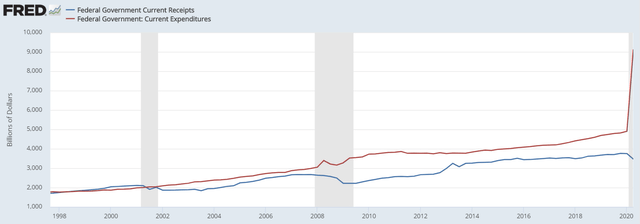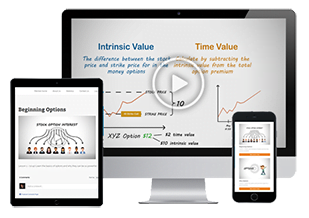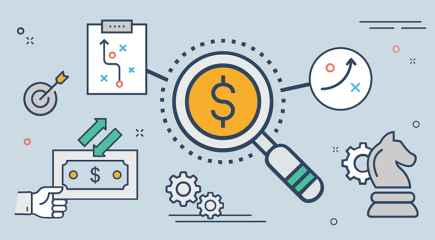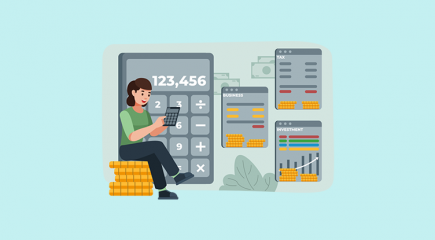The U.S. is about to embark on a very ominous journey into hyperinflation with record amounts of debt and deficits.
The latest Q2 2020 This has resulted in an annually adjusted budget deficit of $5.5 trillion, which is shown in the chart below. This is completely unprecedented, and it doesn’t look like the expenditures are going to ease down as many businesses (airlines, event sector, hospitality industry) still struggle due to the pandemic.
 If we calculate the deficit to outlay ratio, we get 60%, which is higher than the 40% hyperinflationary threshold.
If we calculate the deficit to outlay ratio, we get 60%, which is higher than the 40% hyperinflationary threshold.
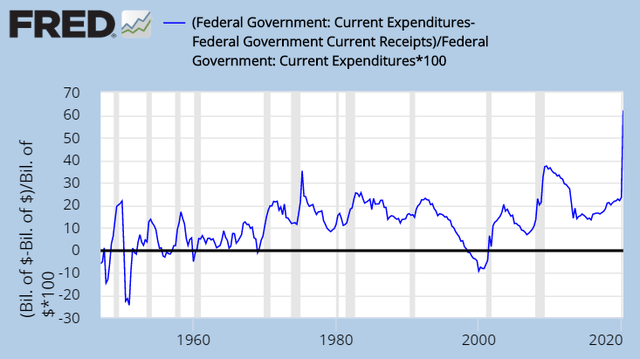 The latest Q2 GDP data was equally abysmal. The U.S. economy shrank 31.7% while the U.S. stock market kept rising. This has resulted in a surge in the total market cap to GDP (Buffett indicator) to 183%, which clearly indicates stocks are very overvalued here. Q3 2020 GDP is expected to rise 26% according to the Atlanta Fed, so this ratio could come down going forward.
The latest Q2 GDP data was equally abysmal. The U.S. economy shrank 31.7% while the U.S. stock market kept rising. This has resulted in a surge in the total market cap to GDP (Buffett indicator) to 183%, which clearly indicates stocks are very overvalued here. Q3 2020 GDP is expected to rise 26% according to the Atlanta Fed, so this ratio could come down going forward.
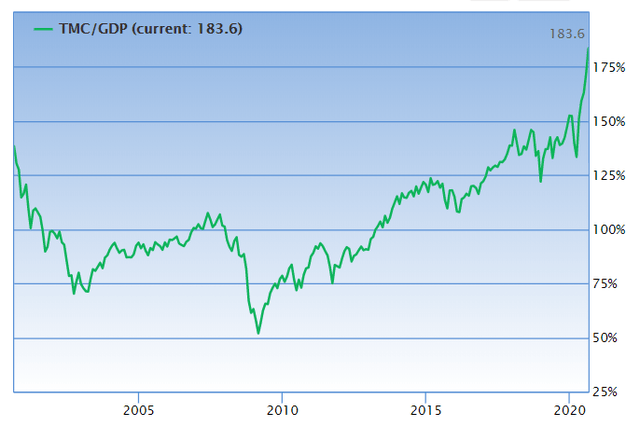 Ultra-low interest rate policies have created a stock market and bond market bubble at high valuation multiples, but the underlying economy is not improving much. For example, small businesses aren’t reopening as witnessed on the chart below from Opportunity Insights.
Ultra-low interest rate policies have created a stock market and bond market bubble at high valuation multiples, but the underlying economy is not improving much. For example, small businesses aren’t reopening as witnessed on the chart below from Opportunity Insights.
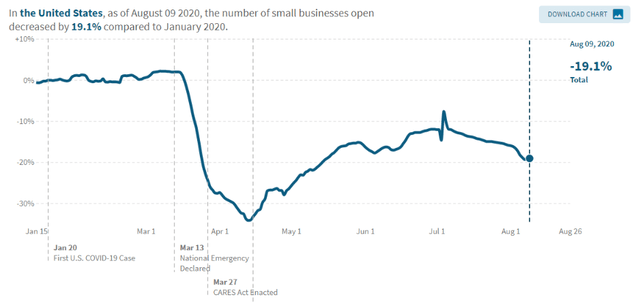 The Federal Reserve has only managed to drown U.S. businesses in more debt as delinquencies are rising on record corporate business debt levels.
The Federal Reserve has only managed to drown U.S. businesses in more debt as delinquencies are rising on record corporate business debt levels.
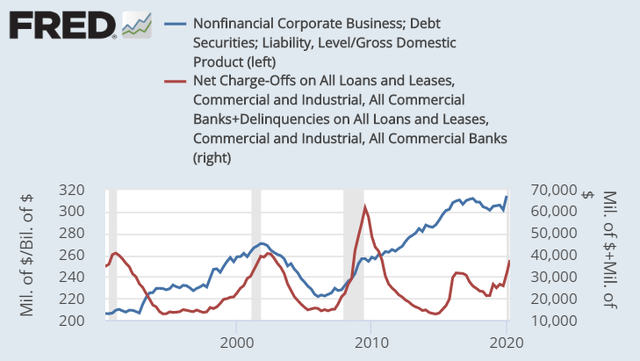 In fact, the Federal Reserve is not done yet. On August 27th, Chairman Powell announced that he will let inflation run hotter than normal and keep interest rates at 0% for an extended period (~5 years). In order to achieve this, the Federal Reserve will have to massively increase its balance sheet via more asset purchases and even sending money directly to businesses. The current bubbles will only grow larger and larger. Stocks will keep rising as the Federal Reserve pumps money into this sector.
In fact, the Federal Reserve is not done yet. On August 27th, Chairman Powell announced that he will let inflation run hotter than normal and keep interest rates at 0% for an extended period (~5 years). In order to achieve this, the Federal Reserve will have to massively increase its balance sheet via more asset purchases and even sending money directly to businesses. The current bubbles will only grow larger and larger. Stocks will keep rising as the Federal Reserve pumps money into this sector.
However, money doesn’t grow on trees. As the Federal Reserve prints more money to buy up assets, the U.S. dollar will plunge and inflation will rise.
The U.S. dollar is correlated to the amount of deficits. As trade deficits and budget deficits rise, the U.S. dollar will need to fall.
 As small- and medium-sized businesses stay closed, real output will decline. Without real output, efficiency in the economy will deteriorate and inflation will soar. I expect inflation to soar above 3% in the coming months based on the current Q2 2020 real output numbers.
As small- and medium-sized businesses stay closed, real output will decline. Without real output, efficiency in the economy will deteriorate and inflation will soar. I expect inflation to soar above 3% in the coming months based on the current Q2 2020 real output numbers.
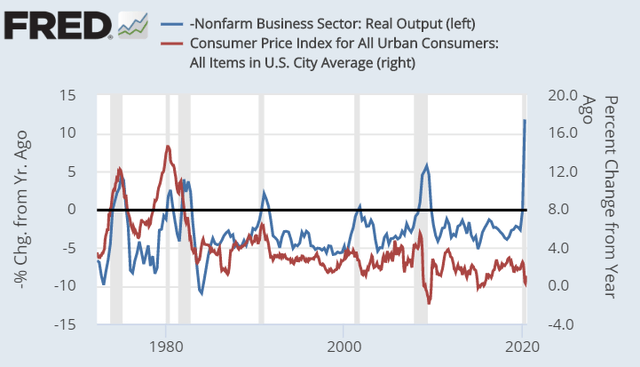 Investors should prepare themselves right now against this inflationary wave. A good example to follow is Warren Buffett, who bought an initial stake in Barrick Gold (NYSE:GOLD) in the last quarter. I suggest we follow the great oracle and stock up on gold and gold miners.
Investors should prepare themselves right now against this inflationary wave. A good example to follow is Warren Buffett, who bought an initial stake in Barrick Gold (NYSE:GOLD) in the last quarter. I suggest we follow the great oracle and stock up on gold and gold miners.
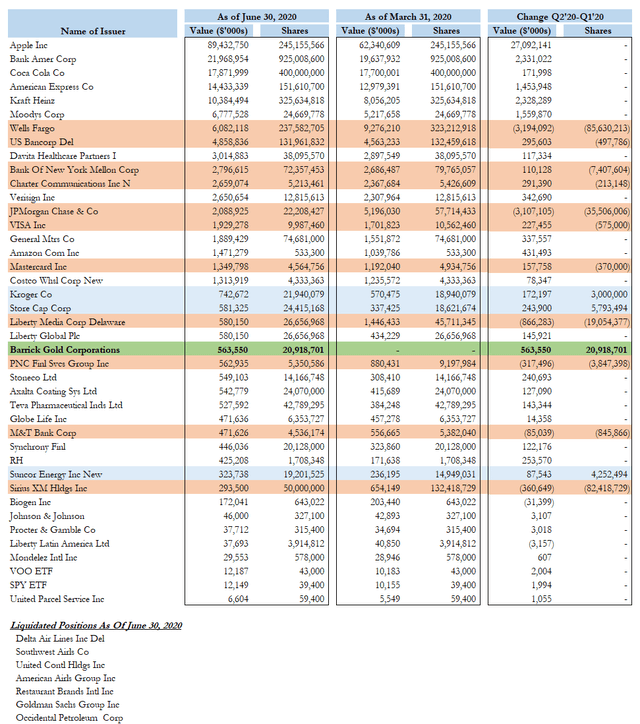
Disclosure: I/we have no positions in any stocks mentioned, and no plans to initiate any positions within the next 72 hours. I wrote this article myself, and it expresses my own opinions. I am not receiving compensation for it (other than from Seeking Alpha). I have no business relationship with any company whose stock is mentioned in this article.
